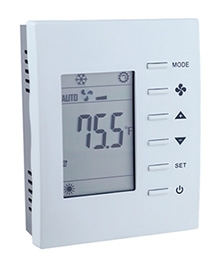Control Network Newsletter

Selecting the Correct BASstat Thermostat
 The popular BASstat Communicating Thermostat Series has several models to ensure effortless integration into BACnet/IP (Wi-Fi) or BACnet MS/TP (EIA-485) networks. Each BASstat model offers distinct benefits that provide flexibility when installing a distributed zone thermostat control system. Don't miss our introductory video to the BASstat Series to better understand the different options.
The popular BASstat Communicating Thermostat Series has several models to ensure effortless integration into BACnet/IP (Wi-Fi) or BACnet MS/TP (EIA-485) networks. Each BASstat model offers distinct benefits that provide flexibility when installing a distributed zone thermostat control system. Don't miss our introductory video to the BASstat Series to better understand the different options.
All the thermostats in the BASstat series are designed for BACnet/IP over Wi-Fi or MS/TP multi-stage rooftop units and analog 4-pipe fan coil units (FCUs). Configurable and adaptive control algorithm applied to multi-stage on/off control saves energy and ensures seamless comfort for the occupants.
All models feature an attractive wall-mounted enclosure with an easy-to-read LCD display that can be set for °C or °F, with graphical icons to indicate setpoint, space temperature, occupancy status, and modes of operation. Six buttons on the BASstat allow users to manipulate temperature set point, change HVAC modes, turn the thermostat ON/OFF, and more. All six of these buttons are lockable in a configurable manner to prevent unauthorized configuration change. Some or all buttons can be locked for application flexibility, making the BASstat suitable for applications where limited user control is allowed.
BAST-121 Single Mode Thermostats
The BAST-121C thermostat is suitable for single-stage or multi-stage heating only or cooling only binary or analog output control applications, such as unitary heating or cooling units. The thermostat can control one or two stages of heating or one or two stages of Direct Expansion (DX) cooling. In addition, a single 0-10V modulated output controls a single analog heating or cooling output device. These capabilities, combined with the unit's configurable control algorithm and BACnet server functionality over MS/TP or Wi-Fi, make this thermostat ideal for single mode heating or cooling applications that require connectivity to a BACnet network.
BAST-221 Multi-Stage Heating/Cooling Thermostats
The BAST-221C thermostat is ideal for single or multi-stage heating, cooling and ventilation binary output control applications such as RTUs or AHUs. A built-in relative humidity sensor (in 221CH models) allows the thermostat to display relative humidity on the screen as well as serve it as a BACnet object, dew point calculation is also served as a BACnet object (no control action is taken based on humidity).
BAST-321 Heat Pump Thermostats
The BAST-321C thermostat is designed for heating, cooling, and ventilation with binary output control for single and multi-stage heat pumps with or without 3rd stage auxiliary heat. It can manage a variety of inputs from single and multi-stage HVAC systems. It can control two DX heat pump compressors, one binary reversing valve, one binary supply fan relay, plus one binary stage of auxiliary heating, either gas or electric, making it ideal for applications that require versatility and adaptability.
BAST-421 Modulating Thermostats
The BAST-421C thermostat is suited for modulated heating, cooling, and ventilation for 4-pipe HVAC systems. Modulated control of FCUs allows the HVAC system to react to load changes within a space quickly and efficiently to provide a more consistent and comfortable environment within a building. The thermostat units help to improve the control and delivery of conditioned air to suit the temperature requirements of an immediate space, which is ideal for applications that require individual temperature control, such as hotel rooms, offices, and apartments. As a result, FCUs maintain a more constant air temperature control, minimizing the time, energy, and cost to ramp up the system to maintain and deliver the desired temperature. Intended for use with 4-pipe heated/chilled water FCUs or air handlers, the BAST-421C thermostat can control two analog modulating water valve actuators and one binary supply fan.
Learn more about the BASstat Communicating Thermostats by watching our introductory video or visiting the BASstat series page.